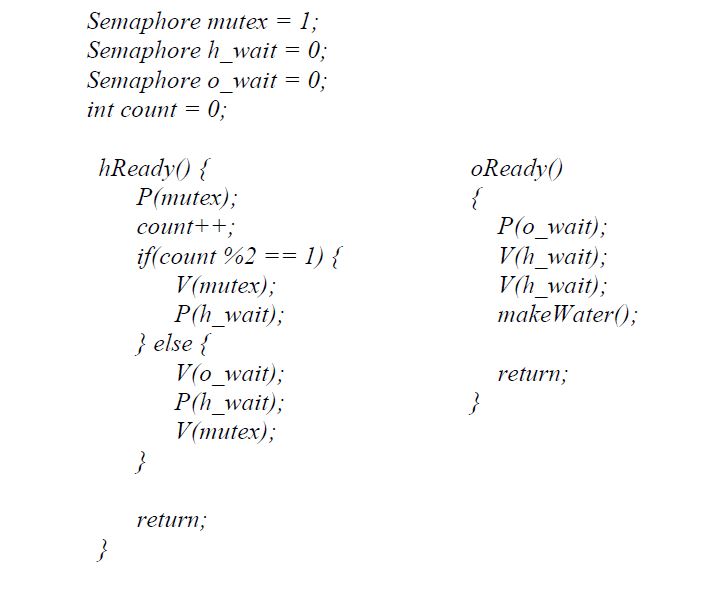This program claims to solve makeWater() synchronization problem. However, I could not understand how. I am new in semaphores. I would appriciate if you can help me to understand this code.
Semaphores makeWater() synchronization
Asked Answered
So you need to make H2O (2Hs and one O) combinations out of number of simultaneously running H-threads and O-threads.
The thing is one 'O' needs two 'H' s. And no sharings between two different water molecules.
So assume number of O and H threads start their processes.
- No O thread can go beyond
P(o_wait)because o-wait is locked, and should wait. - One random lucky H thread(say H*-1) can go pass
P(mutex)(now mutex = 0 and count = 1) and and will go insideif(count%2 == 1), then up-count 'mutex' (now mutex = 1) and block inP(h_wait). (This count actually refers to H count) - Because 'mutex' was up-counted another random H-thread(H*-2) will start to go pass
P(mutex)(Now mutex = 0 and count =2). But now the count is even -> hence it goes insideelse. Then it willV(o_wait)(now o_wait = 1) and stuck inP(h_wait). - Now H*-1 is still at the previous position inside
ifblock. But because o_wait is up-counted to 1, a lucky O thread(O*) can continue its process. It will do twoV(h_wait)s (Now o_wait = 0, h_wait = 2), so that 2 previous H threads can continue(No any other, now h_wait = 0). So all 3 (2 Hs and O) can finish its process, while H*-2 is up-counting the 'mutex' (now mutex = 1). - Now the final values of global variables after completion one molecule, mutex = 1, h_wait = 0 and o_wait = 0, so exactly the initial status. Now the previous process will happen again and again, hence H2O molecules will be created.
I think you get clear with it. Please raise questions if any. :))
It is a great explanation =) I've understood very well! Thanks a lot Supun @Supun Wijerathne –
Turbit
@Turbit always nice to see (Y) :)) –
Fleabag
© 2022 - 2024 — McMap. All rights reserved.

